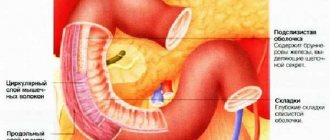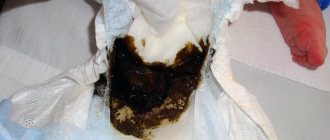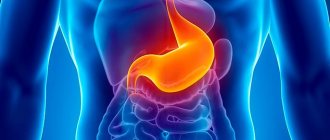Often, expectant parents, while expecting a baby, worry about how to tell if their baby has colic. Having read heartbreaking stories on forums and listened to stories from experienced parents, expectant mothers and fathers worry that they will not be able to recognize these same colics. Naturally, tummy pain in newborn babies is not difficult to identify.
If mom and dad take care of the child, then a month after his birth they will be puzzled by only one question: when does colic in newborns go away? This is not strange, because pain in the tummy is so exhausting for both the baby and mom and dad that everyone eagerly awaits its end.
Colic occurs in all newborns, but it lasts differently. Their duration is influenced by a number of factors, but primarily this process depends on the formation of the gastrointestinal tract. The faster a child’s digestive system adapts to new food, the sooner his colic will go away.
Why colic appears, until what age will it bother the baby and how to determine that the child is crying precisely because of abdominal pain, we will understand further.
What is colic
Colic most often occurs in newborns in the first month of life . There are often cases when this happens earlier or later than the specified period. They usually end by six months.
Not all babies suffer from intestinal spasms . For some, this condition passes painlessly - the mucous membrane is quickly populated by microflora. Other children experience little pain, so parents don't always notice the symptoms.
In most cases, colic in newborns at night is accompanied by severe cramps , especially after the last meal.
Infants experience the following symptoms:
- restlessness, frequent awakenings and crying;
- the child presses his legs to his body, clenches his hands into fists;
- the face turns red;
- upon completion of an attack of abdominal pain, an act of defecation occurs, accompanied by the release of gases.
Such manifestations are typical for all newborns , so the pediatrician can quickly make a diagnosis. The condition is not pathological - it is a normal physiological process.
Parents often ask pediatricians what the difference between so-called gas and colic is. In the first case, this is the process of gas formation in the lower parts of the digestive tract with the formation of air bubbles. They cannot get out, so the baby experiences discomfort and cries. His condition is alleviated by the introduction of a gas tube.
Colic is a spasm in the intestines , which can be accompanied by gas formation and is not always eliminated by the described method, since the gases leave, but the spasm remains.
Interesting on the topic:
Why and how to massage a newborn with colic
The best medications for colic in newborns
We select a mixture for colic and constipation in newborns
How long does intestinal colic last in newborns?
In the first three months of life, more than 70% of children experience functional intestinal colic . In the vast majority of cases, these colics are not a pathology (disease), but an adaptation of the baby’s gastrointestinal tract (GIT) to new conditions
. After all, before this, the baby’s gastrointestinal tract “did not work” for 9 months, and for the first 2-3 weeks it was under the beneficial influence of maternal hormones.
Usually, in the first two weeks of life, the baby receives exclusively breast milk . Its volumes are small, so digestion is quite easy. By the third week of life, the volume of milk needed for the baby increases
, and for many mothers, due to improper attachment or insufficient time spent at the breast (remember the old recommendations - 15-20 minutes - no more!) milk “decreases”, and the baby receives more “foremilk”, excessively saturated with
carbohydrates , which can promote increased gas formation.
All parents are familiar with this picture: during feeding or shortly after it, your baby suddenly begins to press his legs to his tummy and show restlessness. And then he suddenly turns red and starts screaming; this situation can continue for quite a long time. This is “intestinal colic”.
The term colic comes from the Greek kolikos, which means pain in the colon. Colic is paroxysmal pain in the abdomen, accompanied by severe anxiety in the child . The causes of colic are varied: the functional immaturity of the neuromuscular system and the intestinal enzymatic system, and the tendency to increased gas formation, which results in increased pressure on the intestinal wall and muscle spasm.
There is a certain pattern in the manifestation of colic, the so-called “Rule of Three”:
- colic begins by three weeks of life;
- lasts about three hours a day;
- occur predominantly in children in the first three months of life.
What can parents do to help their baby? First of all, calm down. Relieving psychological stress and creating an aura of confidence helps reduce pain. The baby should feel that you are not afraid of anything and will definitely help him.
To make it easier for the pediatrician to understand this situation, you must answer the following questions:
- when colic occurs: before or after feeding (this will allow you to correctly choose the most comfortable position for the child and clearly know at what time it is better to give medications that relieve pain);
- the duration of colic in time and its increase during the day;
- The time of the most severe colic is morning, evening, night. Are the hours always the same? Reaction to weather;
- type of feeding (breastfeeding, artificial formula (which)).
If your baby is breastfed, everything is much simpler: make sure your baby is latched onto the breast correctly and allow him to nurse for as long as he wants - and this alone can solve all the problems.
If the mother does not like cow's milk and rarely drank it before pregnancy or after it nausea, flatulence, and loose stools appeared, then it is better to replace the milk with fermented milk products during breastfeeding.
If breast milk is not enough and you are forced to supplement your baby with formula, if your baby was born a little premature, if the birth was difficult, these reasons, unfortunately, can contribute to more severe and frequent colic. Frequent changes in weather can increase the symptoms of intestinal colic.
In pediatrics, the following measures are used to treat functional intestinal colic and relieve pain in infants.
- To relieve the severity of pain at the time of colic, the following are used sequentially (each subsequent action in the absence of the effect of the previous one): heat, change of position, as well as mechanical means - a gas tube or an enema.
- For preventive purposes, it is advisable to use background drugs with carminative and mild antispasmodic effects based on plant materials. The best results are shown by the use of PLANTEX tea, which contains fennel fruits, its essential oils and lactose.
- Fennel fruits and essential oils stimulate digestion, increasing the secretion of gastric juice and enhancing intestinal motility, so food is broken down and absorbed faster. The active substances of the drug prevent the accumulation of gases and promote their better removal.
It should be noted that PLANTEX tea contains lactose. Now that all parents are hearing the diagnosis of lactase deficiency, this can cause anxiety. But:
- firstly, the frequency of this diagnosis is incredibly overestimated;
- secondly, a study of fecal carbohydrates (on the basis of which this diagnosis is sometimes made) does not indicate a diagnosis of “lactase deficiency”;
- thirdly (and most importantly!) lactose is necessary for a child to develop the brain; it’s not for nothing that there is so much of it in breast milk!
A special study on the use of PLANTEX as background therapy in children with intestinal colic of early age was conducted at the Center for Correction of Development of Infant Children of the Federal State Institution of the Moscow Research Institute of Pediatrics and Pediatric Surgery. Studies have shown that PLANTEX tea has a calming and carminative effect. PLANTEX is recommended to be given to children after feeding or between feedings. If the baby is bottle-fed, it is recommended to give PLANTEX tea as a drink. Suitable dosages: 1 packet per day for young children, increasing to 2 packets per day for children after 2-3 months.
The main thing is to remember that all this is temporary; if all the recommendations are used correctly, this period can pass quite easily and not overshadow the joy of the first months of motherhood!
Reasons for appearance
There are physiological and pathological causes of spasms in the intestines in infants.
The first include the following factors:
- improper grip of the nipple, sucking, position of the child’s body while eating;
- content in the mother’s diet of foods that lead to excessive gas formation (cabbage, legumes);
- maternal fatigue, depression, anxiety;
- drinking foremilk without creating hindmilk, because the woman takes the breast too early or the baby falls asleep quickly;
- incorrectly selected mixture or violation of the rules for its preparation;
- a large amount of air swallowed by the newborn, which moves into the gastrointestinal tract.

Diseases that can lead to intestinal cramps:
- enterocolitis – inflammation of the mucous membrane of the small and large intestines;
- lactase deficiency, allergy to dairy products in the mother or baby;
- cystic fibrosis - production of excessively thick mucus by the glands of the respiratory system, gastrointestinal tract, etc.;
- dysbacteriosis – a violation of the microflora of the lower gastrointestinal tract;
- hypovitaminosis – lack of vitamins in the body of the mother or baby;
- intestinal infection;
- Crohn's disease is a chronic inflammatory process that affects all membranes (mucous, submucosal, muscular) of the gastrointestinal tract.
Pathological causes of spasms are rare. Basically, the condition is associated with the body’s reaction to the colonization of microflora.
Why do they start at night or in the evening?
Parents often notice that spasms occur in the baby in the evening and at night . This is explained as follows:
- consumption of gas-forming foods by the mother for dinner before the last feeding;
- due to fatigue, the mother may not hold the baby correctly during night feeding;
- fatigue of the infant, who experiences severe pain, reaching its peak in the evening, due to lack of sleep;
- features of the autonomic nervous system of a child, which is most sensitive in the evening and at night.
Important! Since infants eat every 2-3 hours, cramps can occur at any time of the day. They usually intensify before defecation.
Symptoms
The symptoms of intestinal colic in an infant are different from the colic that worries an older child. Acute pain in the abdomen begins to bother the baby 5–15 minutes after feeding or even during it. The baby begins to cry loudly, regurgitate food and act agitated. His tummy tightens and becomes very hard. The process of the digestive tract is disrupted.
If at this moment you try to give the baby food, he will simply refuse it.
In children over 1 year of age, symptoms are severe:
- intensity of spasms;
- bloating and severe pain;
- stool disorder;
- rumbling in the baby's stomach;
- the appearance of mucus in the stool;
- deterioration of health;
- general weakness.
Symptoms of dizziness are also possible. At the first signs of colic in a child, it is important to seek help from a specialist, since the symptoms of the disease often accompany pathologies of the digestive system.

60 minutes after each meal, you should bathe your baby in a warm bath, after adding mint, chamomile and oregano.
How to help your baby
There are several ways to alleviate the condition of a newborn with colic without the use of medications:
- Change body position. If the baby usually lies on his back, he can be turned onto his stomach or side (a blanket should be placed under his back to prevent him from rolling over).
- Carry in a column. This technique will be most effective immediately after eating, so that gases from the esophagus and stomach escape without reaching the intestines. You can also carry a baby in a column every night while crying, so that he calms down.
- Place the baby on the mother's stomach. The feeling of warmth will stop the spasms. Another option is to place a heating pad with warm water on the baby's stomach, after measuring the temperature so as not to burn him.
Such methods are effective if the baby experiences minor spasms . For excessive muscle contractions, it is recommended to use medications.

Most often, pediatricians advise using:
- "Espumizan baby";
- "BabyCalm";
- "Dill water";
- "Plantex".
Important! The listed medications are classified as herbal medicines, so it is recommended to first consult with a pediatrician. If a child is prone to allergies, he may experience rashes, redness, and an inflammatory reaction.
Doctors often recommend the use of drugs that populate the intestines with beneficial microflora - probiotics:
- "Linex";
- "Normobakt";
- "Lactobacterin";
- "Acipol."
If the cause of the condition is lactase deficiency , enzyme preparations are prescribed. The most effective of them is considered to be “Lactazar”.
What is contraindicated to do
Every mother should know a few simple rules to prevent excessive spasm of the intestinal walls in a child :
- It is not recommended to put your baby to the breast too often. This must be done every 2-3 hours, waiting until he has completely sucked the breast. Otherwise, the milk will not have time to digest, which will put a greater burden on the gastrointestinal tract.
- It is prohibited to use medications without the permission of a pediatrician. Some of them can cause an allergic reaction, while others are simply unnecessary. For example, a child without lactase deficiency should not be given enzymes.
- Painkillers can be given to the baby only in extreme cases (for example, Nurofen, approved from birth).
- After feeding, do not immediately put the baby to bed. You need to carry it in a column for some time to allow the gases that have entered the stomach to escape.
Following these recommendations will help the baby quickly overcome the painful condition.

Correct feeding technique for colic
Proper breastfeeding is a very important factor in reducing the intensity of a baby’s colic, because with proper feeding techniques, the baby will not swallow air.
Let's consider the basic rules of proper breastfeeding:
- Offer the breast until the baby is too hungry. The baby’s behavior itself will help: restlessness, smacking lips, sucking fingers. If you miss the right moment, with severe hunger, the baby will begin to actively eat milk, swallowing air along with it. When air enters the body, it can increase gas formation and increase the likelihood of colic occurring and intensifying.
- Apply correctly to the breast. To prevent air from being swallowed, you should learn how to properly apply your baby to the breast. Make sure that the baby opens his mouth wide, directs the breast so that the nipple is directed towards the baby's sky. The child should completely grasp the areola of the nipple, turning out the lower lip. The main sign of an incorrect latch is discomfort and pain during feeding.
- Choose a position for feeding. Correct feeding position can reduce the risk of your baby swallowing air and causing gas. To do this, it is important to follow the following rules:
- the baby's head should be slightly higher than the chest;
- try not to change position during feeding;
- choose the most comfortable position for both mother and child.
Advice from pediatricians
In most cases, colic is a normal physiological process . It is impossible to prevent the colonization of the intestines by microorganisms. But if a woman follows the basic rules for feeding and caring for a baby, the risk of excessive spasms of muscle tissue will decrease.
To make it easier for a baby to go through a period of colic, pediatricians recommend the following:
- mother should eat properly, not consume harmful foods, nicotine, alcohol and illegal drugs;
- frequent walks in the fresh air are always beneficial for the child;
- Every day before bedtime, you should bathe the baby in warm water (the temperature should not exceed 36°C);
- take massage courses from a pediatric specialist (start approximately from the first month of the baby’s life);
- maintain optimal temperature and humidity in the room.










